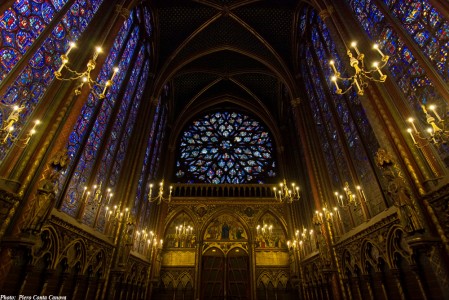By Nelson Fragelli.
Numerous are the splendors of the Middle Ages that can be seen in castles and cathedrals and the charm of city life is easily seen in quaint villages or large cities with imaginative architecture. This splendor is also seen in the bravery and honor in defense of Christian Civilization and the immense advances in scientific and technological progress.
All these splendors were founded on a single splendor: the splendor of virtue under the impulse of the holy Catholic Church.
Is Technology Ruining Your Life? Take A Quick Quiz To Find Out By Clicking Here.
Only an alliance between the builders of the Middle Ages and the supernatural were able to take Europe out of barbarianism and give it a soul deserving the sweet name of Christian.
Of divine institution, the Church gives man a desire to seek perfection in everything. First, a longing for the perfection of her virtues – that is, sanctity – and then an appetite to create a civilization in which the sublime is present in everything man does.
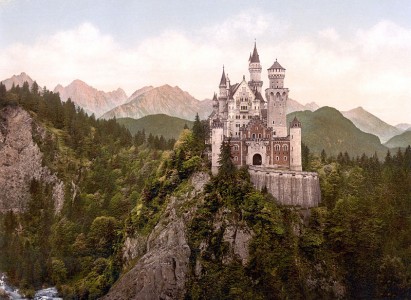 This quest for the sublime can be seen in the mysterious magnificence of castles, monasteries and cities. Similar to the light of the rising sun that steadily chases darkness away, this pursuit of the sublime permeated every field of human activity. The search for personal perfection and refinement in all things is an authentic manifestation of the love of God.
This quest for the sublime can be seen in the mysterious magnificence of castles, monasteries and cities. Similar to the light of the rising sun that steadily chases darkness away, this pursuit of the sublime permeated every field of human activity. The search for personal perfection and refinement in all things is an authentic manifestation of the love of God.
Our Catholic formation is aimed at the spiritual and intellectual formation of its participants. This formation should give us the means to attract those who wander about this chaotic world but still keep feelings and thoughts akin to the ideals we fight for. Many of them, disoriented, simply drift about in a world dominated by contemporary confusion. So we need to be practical. We need to communicate very well and be capable of making ourselves understood by those in whose hearts a flame of hope still flickers and a fire glows among dying coals.
In order to understand the splendor of the Middle Ages we need to answer this question:
How did people live in the Middle Ages? Were they poor? Oppressed? Were their homes comfortable? How were their daily relationships, production and commerce, industry and finance? How did they use money and credit? Are the Middle Ages worthy of admiration only because of the monks who lived in beautiful monasteries and bishops that officiated in sumptuous cathedrals?
What other perfections could be seen in medieval social organization besides the splendor of cathedrals, the pensive environment of monasteries, and the lofty castles?
 “Return to Order” is the title of the most recent book by the American TFP, authored by Mr. John Horvat. The book is a best seller with more than 25,000 copies sold in the United States. It provides information little known to the public at large, which enables us to answer this question: Is the holiness that is found in monasteries and cloisters also attainable in ones practical day-to-day life in society? Supported on hundreds of modern authors, this book corroborates the conception of Plinio Corrêa de Oliveira about the social work of the Church.
“Return to Order” is the title of the most recent book by the American TFP, authored by Mr. John Horvat. The book is a best seller with more than 25,000 copies sold in the United States. It provides information little known to the public at large, which enables us to answer this question: Is the holiness that is found in monasteries and cloisters also attainable in ones practical day-to-day life in society? Supported on hundreds of modern authors, this book corroborates the conception of Plinio Corrêa de Oliveira about the social work of the Church.
“Return to Order” calls the social order that existed in the Middle Ages, “organic society.”
The goal of organic society is oriented toward the common good. What is the common good? The common good is the living and active notion toward which every social interchange must be aimed, not only at one’s own advantage but also at the good of neighbor, his Religion, family, and any good organization to which he belongs.
Just as in a living being we find cells, tissues, organs and systems working together to keep an organism alive, so also in a society we find families, lineages and associations of all kinds, each with its own unique function and sphere of activity, and all of them connected and working together for the common good of the society.
Organic society substantially differs from the mechanical and profit-oriented notion of modern society. An organic society is one, which is in harmony with our nature.
Let’s consider economic matters. During those days of primeval faith, commercial transactions banished fraud, false advertising, deceit and misrepresentation of the quality of goods and services. Simply put, companies shunned lying. Fraud leads to dishonor and consequently, to ruin. In the commercial world, every party oriented its actions according to morals, established customs and promoted the dignity of family and community.
Property was a sacred value. The mystical charisma of monasteries and abbeys indelibly marked the character of towns and regions as we still see in Europeans countries to this day.
A distinctive feature of the Middle Ages is its great material progress. There was a reason for that richness. Its driving force was a solid moral and psychological social fabric based on virtue.
As a consequence of his profound instinct of sociability, man can only attain his full development in harmony with others. This is because man is a finite social being. This harmony was ensured by the quest for the common good. Religious orders, active in the bosom of society, set a living example of virtues that moved everyone to work toward the common good.
What were the cathedrals but magnificent gifts from monks and clergy to the society in which they lived? Entirely open to the people, the cathedrals were even more magnificent than castles. They set a standard of perfection desired by all society. Their construction revealed talents and qualities theretofore nonexistent. In the Middle Ages, the quest for perfection became an ideal.
The Church exerted Her authority with maternal goodness as She watched over Her flock.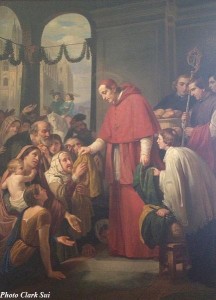 With motherly care She discerned the necessary good and inspired and encouraged everyone; and in Her wisdom, She made corrections when needed. She made sure people would enhance what they received from tradition by adapting it to their concrete and changing circumstances.
With motherly care She discerned the necessary good and inspired and encouraged everyone; and in Her wisdom, She made corrections when needed. She made sure people would enhance what they received from tradition by adapting it to their concrete and changing circumstances.
The practice of virtue automatically leads to a superior ordering of society. This order gave peoples the stability and balance our society no longer possesses.
Man acquires a vigorous soul when God directs his reason, which in turn dominates his will, which governs his sensibility. This is the proper order of the soul and is the foundation of every well-structured society; this was the medieval virtue par excellence.
In practice, the social order was made up by the habits proper to each people, the customs and behavior of peasants and city dwellers, those who sold and those who bought.
In his human relations, medieval man continually referred to the moral universe taught by the catechism and explained from the pulpit. In their families, in their productive activities, in commerce etc., everyone kept that moral universe in mind. For example, what dominated commercial transactions among traders was not the financial advantage that might arise as a consequence of their negotiations but rather the preservation of the moral order and the common good. This can be seen in confession manuals that were produced as a moral guide for the economy.
Justice was one of the dominant virtues in medieval society. This statement may sound highly utopian to modern ears. “If one word were sought to cover all phases of medieval economic teaching,” writes Sir Alexander Gray, “it would probably be found in the idea of justice” (Development of Economic Doctrine, p. 35).
St. Thomas Aquinas defines justice as the virtue of “giving every one his due.” In other words, justice in transactions means giving the other party his due. Justice in transactions requires therefore that the price paid for a certain good service corresponded to its real value.
Things were valued on the basis of a standard of justice. “The purpose of the merchant profession,” writes medieval moralist Alexander Ariosto, “must not be accumulating riches but supporting his family, helping the poor and rendering service to the community.”
To our ears this is a fantastic statement, confirmed furthermore by countless medievalist authors.
The manuals of theology and moral treatises that oriented economic relations in those times contain jewels of wisdom and prudence that calmly ponder man’s flexible needs.
The confessional manual by Godescalc Rosemondt lists eight ways by which just price might be determined. While the moral judgment was rigorous, the determination of the price was neither rigid nor inflexible.
Diana Wood affirms that the balance of justice was based not on precision but on more flexible reason and common sense. It was a question of virtue rather than econometrics.
Charity also had a healthy moderating influence on the economy. Moralists and theologians posited that the fires of avarice could be extinguished with the practice of charity toward one’s neighbor.
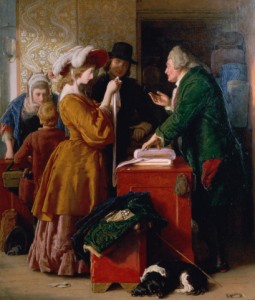
Just prices and salaries were maintained especially with the needs of the poor people in mind. Without charity, even the best regulations by well-intentioned men in the interest of the common good are to no avail.
There were literally hundreds of confession manuals with successive editions, which defined a penitential doctrine and a tradition of dealing with personal economic questions from the standpoint of justice.
Norwegian economist Odd Langholm analyzed ninety of these confession manuals in his book, The Merchant in the Confessional: Trade and Price in the Pre-Reformation Penitential Handbooks. From his brilliant analysis, he deduces a practical economic doctrine found in Scholastic thought. In other words, the philosophical principles laid down by Saint Thomas Aquinas penetrated the rules of trading.
During the Renaissance, this passion for justice diminished. Later, some currents within the Pseudo-Reformation, and especially those within Calvinism, helped open the floodgates of greed by claiming that the danger of accumulating wealth no longer posed an obstacle to salvation.
Let us examine an example that does not come from the Middle Ages but reflects the spirit of the Church, which formed the Middle Ages.
A conversation between St. John Bosco and a simple blacksmith who helped his works shows their quest for perfection:
“Do you know what my main concern is?” the blacksmith asked St. John Bosco.
“It certainly must be to live and die in God’s grace.”
“No, I am not worried about death, though I am careful to prepare for it when it comes. My greatest concern is that I am a blacksmith and become very disturbed when, after finishing a job, I have to decide what price to charge. As I write the price in my book, I ask: Would the good God write the same amount? If I charge more, will I not be accused for it? In order to be safe, I always charge 20% below the normal price.”
This pre-occupation of this successful blacksmith, and many others like him, showed a great concern for justice could only have created an atmosphere favorable to commerce in general.
When honor reigns, the influence of money dwindles, institutions are zealous of their reputation, families defend their good name and Catholic culture flourishes.
When honor prevails, men abundantly employ material goods as a way of making life in society dignified, honest and pleasant to body and soul.
In the Middle Ages, every one cultivated a profession that increased his personal dignity by emphasizing the respectability rather than profitability of his profession.
Indeed, through Her teachings, liturgy and moral example, the Church incorporated principles, ideas and moral values into the social body, inspiring men not to seek profit exclusively but to have an ardent love of God whereby all things were resolved according to the First Commandment.
Thus connected with Religion, organic society was closely linked to a people’s real life, their customs, traditions and ways of being. That was profoundly different from the rigid ideologies of modern thinkers that built “ideal” systems without any link to reality–such as socialism and communism–to the great detriment of mankind.
While closely knit to reality, organic society kept a vertical vision of the universe. Daily life in the Middle Ages, much like the vertical lines and pinnacles of cathedral towers, led one’s gaze up toward the cross that stood atop.
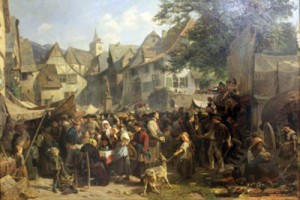 People in that organic society were passionately interested in all things elevated, dignified and noble. When a society looks for what is more elevated, dignified and noble it inevitably finds the supernatural and divine, which are on the summit of all beauty and constitute the true source of Christian Civilization.
People in that organic society were passionately interested in all things elevated, dignified and noble. When a society looks for what is more elevated, dignified and noble it inevitably finds the supernatural and divine, which are on the summit of all beauty and constitute the true source of Christian Civilization.
This quest for the sublime was the most notable splendor of the Middle Ages. It was a transcendental and supernatural vision of society. This was the incomparable magnificence of the Middle Ages.
Upon teaching the catechism and dogmas, the Church instilled in medieval society magnificence and happiness in this world and gave humanity a foretaste of the happiness to come.
“It is true that Augustine had an enormous love of God,” writes historical scholar Henry Osborn Taylor. “It was fervently felt; it was powerfully reasoned; it impassioned his thought. Yet it did not contain that tender love of the divinely human Christ which trembles in the words of Bernard and makes the life of Francis a lyric poem.” Henry Osborn Taylor refers to Saint Bernard and Saint Francis of Assisi.
At this point we could raise a question: was organic society planned by Popes or monks in the silence of their monasteries or in their vast chapter halls?
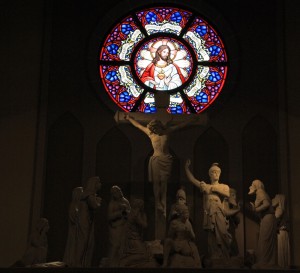 Medieval man did not plan organic society; he simply sought to behave in society as Christ did during His life among us. This is the mysterious power of organic society. This is the secret of the Middle Ages.
Medieval man did not plan organic society; he simply sought to behave in society as Christ did during His life among us. This is the mysterious power of organic society. This is the secret of the Middle Ages.
Even today, in the midst of this century of impiety and disorder, if we could but have a similar, lively and loving idea of Jesus Christ we would want what they wanted and obtain what they received. This is the secret of every possible restoration of our present society.
What could be the secret of medieval organic society? It is found in a mysterious unity among Bonum, Verum, and Pulchrum–goodness, truth and beauty. The Good was represented by the search for Justice. Truth denoted the profession of Catholic teachings and beauty was the quest for the sublime. The following words of Pope Leo XIII in his Encyclical Immortale Dei may shed light on this mystery:
 “There was a time when the philosophy of the Gospel governed the states. In that epoch, the influence of Christian wisdom and its divine virtue permeated the laws, institutions, and customs of the peoples, all categories and all relations of civil society. Then the religion instituted by Jesus Christ, solidly established in the degree of dignity due to it, flourished everywhere thanks to the favor of princes and the legitimate protection of magistrates. Then the Priesthood and the Empire were united in a happy concord and by the friendly interchange of good offices. So organized, civil society gave fruits superior to all expectations, whose memory subsists and will subsist, registered as it is in innumerable documents that no artifice of the adversaries can destroy or obscure.”
“There was a time when the philosophy of the Gospel governed the states. In that epoch, the influence of Christian wisdom and its divine virtue permeated the laws, institutions, and customs of the peoples, all categories and all relations of civil society. Then the religion instituted by Jesus Christ, solidly established in the degree of dignity due to it, flourished everywhere thanks to the favor of princes and the legitimate protection of magistrates. Then the Priesthood and the Empire were united in a happy concord and by the friendly interchange of good offices. So organized, civil society gave fruits superior to all expectations, whose memory subsists and will subsist, registered as it is in innumerable documents that no artifice of the adversaries can destroy or obscure.”



